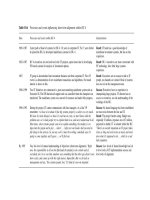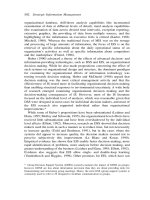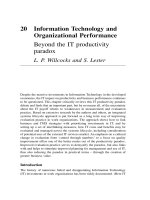Managing information systems 7th edition brow ch04
Bạn đang xem bản rút gọn của tài liệu. Xem và tải ngay bản đầy đủ của tài liệu tại đây (604.25 KB, 37 trang )
MANAGEMENT INFORMATION SYSTEMS
CHAPTER 4
THE DATA RESOURCE
Copyright © 2011 Pearson Education, Inc. publishing as Prentice Hall
4-1
PART 1: IT BUILDING BLOCKS
Copyright © 2011 Pearson Education, Inc. publishing as Prentice Hall
4-2
WHY MANAGE DATA?
- What costs would your company incur if it did not comply with
SOX or other financial reporting laws?
- What would your company do if its critical business data were
destroyed?
- What costs would your company incur if sensitive data were stolen
or you violated HIPAA requirements to protect healthcare data?
- How much time does your company spend reconciling inconsistent
data?
- How difficult is it to determine what data are stored about the part
of the business you manage?
- Do you know all the contacts a customer has with your
organization?
Copyright © 2011 Pearson Education, Inc. publishing as Prentice Hall
4-3
TECHNICAL ASPECTS OF MANAGING DATA
DATA MODELS
• An overall “map” for business data
• Involves:
• A methodology (process) to identify and describe data entities
• A notation = a way to describe data entities
Copyright © 2011 Pearson Education, Inc. publishing as Prentice Hall
4-4
DATA MODEL: CONCEPTUAL DESIGN PHASE
ENTITY-RELATIONSHIP DIAGRAM (ERD)
- Entities = things about which data are collected
(e.g., Customer, Order, Product)
- Attributes = actual elements of data to be collected
- Relationships = associations between entities
(e.g., Submits, Includes)
MOST COMMON DATA MODEL FOR CONCEPTUAL DESIGN PHASE
Copyright © 2011 Pearson Education, Inc. publishing as Prentice Hall
4-5
TECHNICAL ASPECTS
METADATA
• Data about data
• Unambiguous data description
• Documents “business rules” that govern data (e.g., type of data
such as alphanumeric; whether a name can change; etc.
• Quality data requires high-quality metadata
Copyright © 2011 Pearson Education, Inc. publishing as Prentice Hall
4-6
DATA MODEL: LOGICAL DESIGN PHASE
NOTATION
• ERDs are converted into sets of Relations, or Tables:
– Structure consisting of rows and columns
– Each row represents a single entity
– Each column represents an attribute
Copyright © 2011 Pearson Education, Inc. publishing as Prentice Hall
4-7
DATA MODELING
LOGICAL DESIGN NOTATION
ERD Example:
Copyright © 2011 Pearson Education, Inc. publishing as Prentice Hall
Convert ERD to relations:
4-8
TECHNICAL ASPECTS: DATA MODELING
ENTERPRISE MODELING
- Top-down approach
- High-level model
- Describes organization and data requirements at high level,
independent of reports, screens, or detailed descriptions of
data processing requirements
Copyright © 2011 Pearson Education, Inc. publishing as Prentice Hall
4-9
ENTERPRISE MODELING
Future-oriented Corporate Data Model
– Divide work into major
functions
– Divide each function into
processes
– Divide processes into
activities (e.g., forecast
sales for next quarter)
– List data entities assigned to
each activity
– Check for consistent names
Copyright © 2011 Pearson Education, Inc. publishing as Prentice Hall
4-10
TECHNICAL ASPECTS: DATA MODELING
VIEW INTEGRATION
• Bottom-up approach
• Each report, screen, form, and document produced from
databases (called user views) is identified
– Create user views
– Identify data element in each user view and put into a
structure called a normal form
– Normalize user views
– Combine user views
– Reconcile any differences with enterprise model
Copyright © 2011 Pearson Education, Inc. publishing as Prentice Hall
4-11
TECHNICAL ASPECTS: DATA MODELING
TECHNICAL ASPECTS: DATA MODELING
NORMALIZATION
• The process of creating simple data structures from more complex ones
using a set of rules that yields a stable structure.
Copyright © 2011 Pearson Education, Inc. publishing as Prentice Hall
Source: Kenneth C. Laudon and4-12
Jane P. Laudon
TECHNICAL ASPECTS: DATA MODELING
PACKAGED (UNIVERSAL) DATA MODELS
• Advantages:
- Developed using proven components
- Requires less time and money
- Easier to evolve
- Will easily work with other applications from the same vendor
- Provides a starting point for requirements
- Promotes holistic and flexible views
- Easier to share data across organizations in same industry
Copyright © 2011 Pearson Education, Inc. publishing as Prentice Hall
4-13
TECHNICAL ASPECTS: DATA MODELING
DATA MODELING GUIDELINES
Objective
Some overriding need
Scope
Coverage for a data model
Outcome
The more uncertain the outcome, the
lower the chances for success
Timing
Start with high-level model and fill in
details as major systems projects
undertaken
Copyright © 2011 Pearson Education, Inc. publishing as Prentice Hall
4-14
TECHNICAL ASPECTS: DATA MODELING
DATABASE PROGRAMMING
Database processing activity can be specified with a:
- Procedural language (3GL)
- One or more special purpose languages (4GL)
Structured query language (SQL)
Data exchange language (XML)
Example: SQL Query
SELECT OrderID, CustomerID, CustomerName, OrderDate
FROM Customer, Order
WHERE OrderDate > ‘04/12/11’ AND
Customer.CustomerID = Order.CustomerID
Copyright © 2011 Pearson Education, Inc. publishing as Prentice Hall
4-15
MANAGERIAL ISSUES
PRINCIPLES IN MANAGING DATA
1.
2.
3.
4.
5.
6.
7.
The need to manage data is permanent.
Data can exist at several levels within the organization.
Application software should be separate from the database.
Application software can be classified by how it treats data.
Application software should be considered disposable.
Data should be captured once.
There should be strict data standards.
Copyright © 2011 Pearson Education, Inc. publishing as Prentice Hall
4-16
MANAGERIAL ISSUES
PRINCIPLES
Copyright © 2011 Pearson Education, Inc. publishing as Prentice Hall
4-17
PRINCIPLES IN MANAGING DATA
1. The Need to Manage Data is Permanent
•.
Data values may change, but a company will always have
customers, products, employees, etc. about which it needs
to keep current data
•.
Business processes will change, but only the programs will
need to be rewritten
Copyright © 2011 Pearson Education, Inc. publishing as Prentice Hall
4-18
PRINCIPLES IN MANAGING DATA
2. Data can exist at several levels within an organization
• Most new data are captured in operational databases
• Managerial and strategic databases typically subsets,
summaries, or aggregates of operational databases
• If managerial databases are constructed from external sources,
there may be problems with data consistency
Copyright © 2011 Pearson Education, Inc. publishing as Prentice Hall
4-19
PRINCIPLES IN MANAGING DATA
3. Application Software should be separate from the database
• Application independence = separation or decoupling of
data from application systems
- Raw data captured and stored
- When needed, data are retrieved but not consumed
- Data are transferred to other parts of the organization
when authorized
• Meaning and structure of data not hidden from other
applications
Copyright © 2011 Pearson Education, Inc. publishing as Prentice Hall
4-20
PRINCIPLES IN MANAGING DATA
Copyright © 2011 Pearson Education, Inc. publishing as Prentice Hall
4-21
PRINCIPLES IN MANAGING DATA
4. Application Software can be classified by how it treats data
Data capture: gather data and populate the database
Data transfer: move data from one database to another or
otherwise bring data together
Data analysis and presentation: provide data and information to
authorized persons
Copyright © 2011 Pearson Education, Inc. publishing as Prentice Hall
4-22
PRINCIPLES IN MANAGING DATA
5. Application Software should be considered disposable
Due to application independence:
- Company can replace the capture, transfer, and presentation
software modules separately if necessary
- Applications and data are not intertwined
- Aging systems do not need to be retained because of the
need to access the data stored in them
Copyright © 2011 Pearson Education, Inc. publishing as Prentice Hall
4-23
PRINCIPLES IN MANAGING DATA
6. Data should be captured once
• Too costly to capture data multiple times and reconcile across
applications
• Instead, data should be captured once and synchronized across
different databases
• Data architecture should include inventory of data and plan to
distribute data
Copyright © 2011 Pearson Education, Inc. publishing as Prentice Hall
4-24
PRINCIPLES IN MANAGING DATA
7. There should be strict data standards
• Data must be clearly identified and defined so that all users know
exactly what they are manipulating
• Only business managers have the knowledge necessary to set
data standards
• Database contents must be unambiguously described, and stored
in a metadata repository or data dictionary/directory (DD/D)
Data steward
A business manager responsible for the quality of data in a
particular subject or process area
Copyright © 2011 Pearson Education, Inc. publishing as Prentice Hall
4-25









